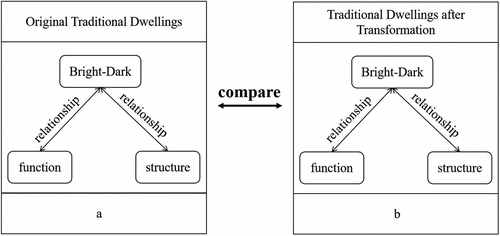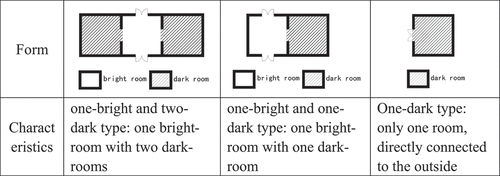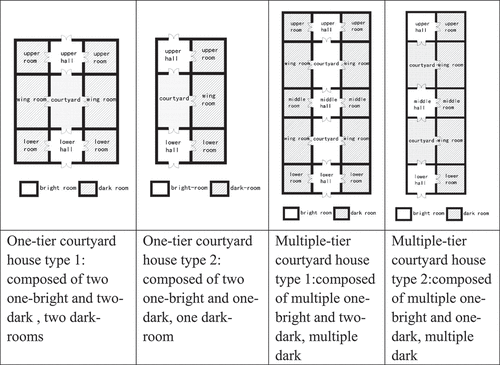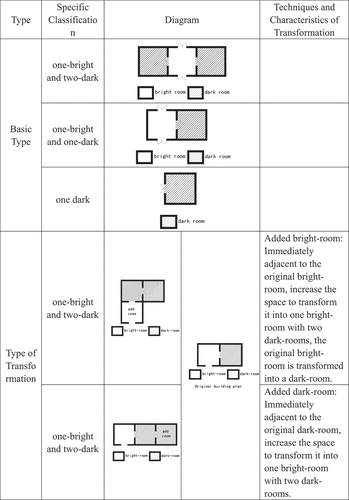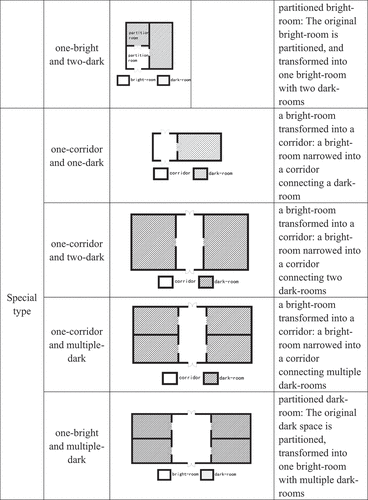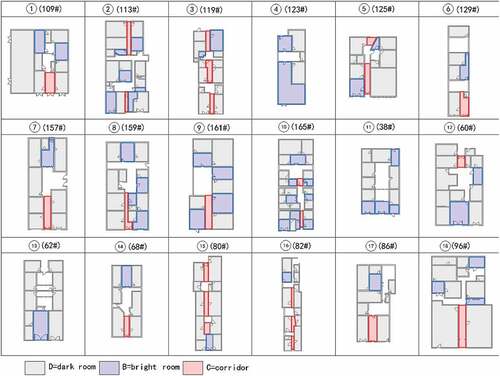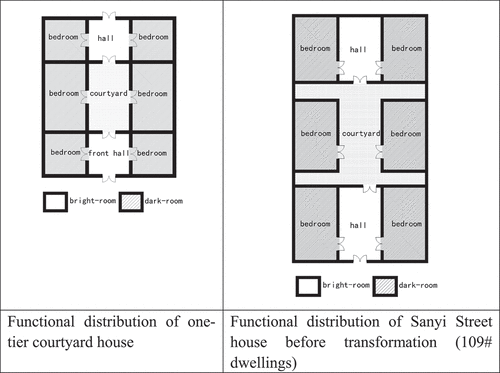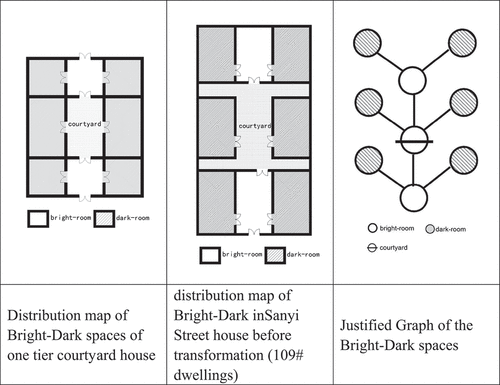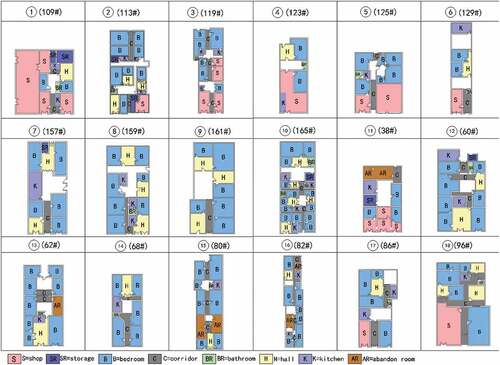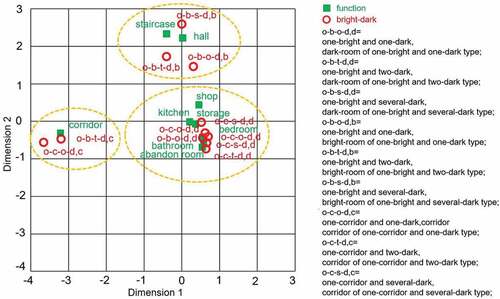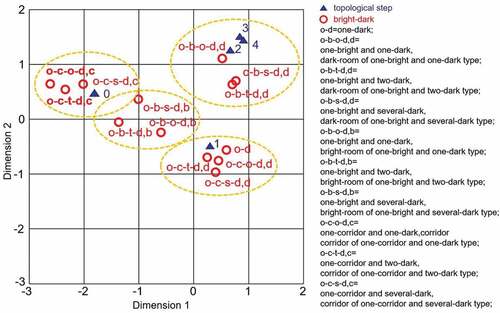ABSTRACT
The spontaneous transformation of traditional residential space is one of the important phenomena in urban development in China, which is generally considered as a disorderly, random, and individual spatial product derived from current life. However, are these transformations really random individual phenomena? With traditional residential dwellings of Sanyi Street in Jingzhou as research objects, this study revealed the inherited characteristics of the concept system of “Bright-Dark” in the process of contemporary transformation of traditional residential dwellings. Typical residential dwellings were selected for surveying and mapping and the expression of the “Bright-Dark” concept system in the current transformed residential space compared with traditional residential space patterns. The results demonstrated the traditional concept system (“Bright-Dark”) of residential space still exerts its spatial control function in the seemingly random transformation of contemporary dwellings. In addition, the study provided new perspectives and methods for understanding contemporary transformation of traditional dwellings from the perspective of the concept system of “Bright-Dark”.
Graphical abstract
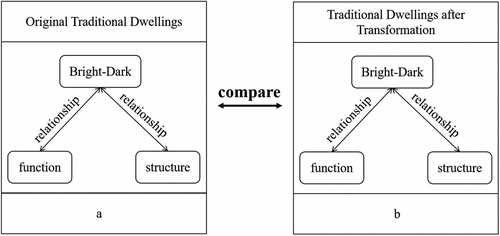
1. Introduction
“Bright-Dark” is a very important concept for describing the traditional Chinese residential spaces. One-bright and two-dark is the basic form of individual buildings in traditional Chinese dwellings (Hou Citation2011), which is the prototype of all residential planar forms and the basis for the formation of residential spatial patterns (Li and Tan Citation2009). Typical traditional Chinese courtyard dwellings developed and evolved on the basis of “one-bright and two-dark” (Liu and Li Citation2012).
In recent years, under the influence of urban development, a large number of traditional dwellings have been transformed spontaneously by the people and the internal spaces of dwellings have been greatly changed to form a product that adapts to the times. Transformed traditional dwellings can meet the needs of current life, but individual residents complete the transformation without any uniform planning and designer input. The transformed spatial form is often uneven, even considered disorderly, random, and individualistic, due to differences in residents’ needs, aesthetics, and economic capabilities. The transformed traditional dwellings can adapt to the needs of the times, but the transformation of traditional dwellings is generally considered disorderly, random, and individual. The concept system of Bright-Dark has always played a leading role in the pattern of traditional residential space in China. However, in the process of continuous transformation of traditional residential dwellings, whether the concept system of Bright-Dark plays an important role in these transformations of traditional residential dwellings and whether such a role remains in the transformed residential spatial pattern is a topic worth studying. This bears practical significance for a deep understanding of the internal logic of the contemporary transformation of traditional dwellings, the protection and inheritance of traditional dwellings, and can also provide a reliable basis for their adaptive development in the process of the times.
The concept of Bright-Dark of traditional Chinese dwellings and its system have been elaborated by many scholars. Hou (Citation2011) has verified the long history and basic pattern of residential buildings, three separated rooms composed of one-bright and two-dark, and pointed out that buildings characterized by three separated rooms composed of one-bright and two-dark is a plane form of the largest quantity, widest distribution, and most extensive application in traditional Chinese architecture. Liu (Citation2009) has analyzed the shape and characteristics of Beijing Quadrangle Courtyards on the basis of one-bright and two-dark. Li and Tan (Citation2009) has proposed that one-bright and two-dark is the basic type of traditional dwellings in Hubei and Hunan provinces, from which various other types are derived. Shen and Lu (Citation2020) have elaborated the distribution characteristics of Bright-Dark rooms in a standard patio-style house composed of one-bright and two-dark rooms. Nan et al. (Citation2001) have discussed in detail the formation of one-bright and two-dark dwellings, while Nan et al. (Citation1999) discussed the planar form and composition characteristics of other Bright-Dark quadrangle courtyard houses in northwest China. These studies have primarily explored representations of Bright-Dark spaces in traditional dwellings under the scope of history and provide a basic reference in this study for summarizing the expression of the concept of Bright-Dark in traditional dwellings in terms of function and structure.
Many studies have been conducted on the contemporary transformation of traditional dwellings in recent years, including research on the influencing factors of transformation (Plaut and Plaut Citation2010), types of transformation (Zhang et al. Citation2021a),use of space after transformation (Zhang et al. Citation2022b), and how transformed spaces affect human access (Zhang et al. Citation2021b). These studies include discussions based on the physical form of spaces and do not investigate the transformation of space at a higher and more original level of traditional spatial conceptual systems. These studies have only focused on the physical spatial form after transformation and only discussed the current space after transformation, for example, summarizing the spatial characteristics after transformation, and modes of utilization. However, these studies have not analyzed the transformed residential space from the perspective of longitudinal historical comparison and not examined the contemporary transformation using a traditional space conceptual system at a primitive level. As a result, few studies have captured the transformation characteristics of the traditional spatial system based on the traditional residential transformation process. In other words, whether the seemingly irregular residential space after the spontaneous transformation is still related to its traditional space conceptual system remains an unsolved problem. This holds significance for the summary of the characteristics of the transformation of traditional residential space, as well as further formulation of the future development direction. At the same time, as introduced above, the Bright-Dark concept is a spatial concept system in traditional Chinese dwellings. Previous studies on Bright-Dark concept only explain the characteristics in the field of history. Those studies have not investigated whether the Bright-Dark concept still exists in the traditional dwellings after spontaneous transformation in contemporary times, or whether it has undergone a transformation.
This study was designed to investigate whether the spatial conceptual system of traditional dwellings still exists or how they have changed in the contemporary transformation of traditional dwellings. This resembles in design the results of a study on the evolution of European dwellings from the 16th to 19th centuries conducted by Evans (Citation1978). He found through case studies that, at this stage of development, the residential plane gradually changed from a matrix of rooms that were interconnected to each other to a “passages plane” (most of its rooms were connected to the middle aisle only by a door). Concurrently, with this spatial evolution, there was a social change in family life from integration to division. This process also witnessed the formation of classes, privacy, and individualism. In addition, Hanson and Hillier (Citation1979) took 47 Yeoman farmhouses in Banbury region of Oxfordshire in the 17th century as the research object and summarized the four types of plane structure that appeared in the relevant cases through structural analysis. On this basis, Hanson and Hillier have further elaborated the correspondence association between the change in the form of the plane structure and changes in family authority and kinds of household activities in the Banbury area from the 17th to 18th century.
Based on the very important conceptual system of Bright-Dark in the traditional residential space, this study defined the established mode of Bright-Dark concept system in the function and structure of traditional residential dwellings through sorting of the literature. Then, cases of the contemporary space were surveyed after the transformation of traditional dwellings and a method of corresponding analysis used to investigate the relationship between Bright-Dark and function as well as the relationship between Bright-Dark and structure through field mapping and quantitative statistics. Finally, whether the conceptual system of Bright-Dark was inherited and represented characteristics represented in transformed dwellings was summarized and the understanding of the individual transformation law of the traditional residential space corrected and expanded. Examining the contemporary transformation of traditional residences from the concept of traditional space behind the form helps improve the current protective development strategy for traditional residences in China, further achieves the inheritance of more cultural connotations in the architectural and urban design process, and realizes the planned protective goal of combining traditional space and contemporary life.
2. Research materials and methods
2.1. Research materials
Sanyi Street is located in the ancient city of Jingzhou, Hubei Province, China. The Jingzhou Ancient City has a long history and includes rich cultural resources with high historical and tourism value. With a history of more than 3,000 years, Jingzhou is a national historical and cultural city, one of the birthplaces of Chu culture, and a famous ancient battlefield of the Three Kingdoms. Since the beginning of the state of Chu in 689 BC, six dynasties and 34 emperors have established their capitals here. There are many historical blocks within the ancient city with well-preserved traditional styles, with Sanyi Street block one of the well-preserved historical blocks in the ancient city. The dwellings in the block were built in the Ming and Qing dynasties, which belong to typical traditional Chinese courtyard dwellings. In more than a hundred years of development, these dwellings have evolved from the original one tier courtyard house to a compound occupied by multiple households.
Although the courtyard-style spatial pattern of the dwellings has been retained, spontaneous transformation is affected by differences in individual functional needs, aesthetics, economic capabilities, and other aspects. These houses are transformed beyond recognition. Their functions, structures, and Bright-Dark characteristics have become chaotic and disorderly(), with multiple mixtures of functions and unclear structural morphology. Their Bright-Dark characteristics are difficult to identify. These complex characteristics of Sanyi Street dwellings are the concentrated expression of large-scale spontaneous transformation, because the traditional residential spaces in the old city have gradually become unadaptable to the modern lifestyle in the context of rapid social development, which is the typical situation faced by traditional dwellings in the extensive old cities of China. Therefore, taking the traditional dwellings of Sanyi Street as the research object is highly representative. The traditional dwellings of Sanyi Street have great historical, cultural, and scientific investigation value. Studying traditional dwellings in Sanyi Street can further explore the value of traditional buildings in the local region, develop ideas and strategies for traditional building protection, and promote the renewal and utilization of regional buildings. This investigation has positive reference significance for protecting China’s architectural heritage. At the same time, as an important part of the ancient city of Jingzhou, the traditional dwellings of Sanyi Street are important tourism and cultural resources. Thus an in-depth study of the traditional dwellings of Sanyi Street allows the public to fully understand the characteristics of regional architecture in the region, further promote the traditional architectural culture, and the development of tourism in the region.
In this study, 18 well-preserved houses on Sanyi Street were selected as study samples(). At the beginning of their construction, these houses were mostly in the form of courtyard-style dwelling of one-story and three separated rooms, usually consisting of two or three-tier courtyards. To meet the needs of everyday life, each household has carried out a large number of additions and reconstructions to the courtyard. In some buildings, the courtyard has been rebuilt, which makes the internal function, courtyard scale, mode of transportation, and connection between the rooms and buildings changed to varying degrees. Shops, living rooms, bedrooms, bathrooms, kitchens, and other functions in the courtyard can coexist. The courtyards and walkway spaces are heavily occupied and the expansion and addition of the building carried out at will. Each of many original rooms is divided into multiple rooms and the rooms not only of different sizes but also nested layer by layer. The entire courtyard is meandering and circuitous and connections between buildings have become chaotic as the number of functions increases. The conceptual system of Bright-Dark is considered to have disappeared in the disorderly transformation of these dwellings and the users have no clear understanding of the relationship between Bright-Dark.
2.2. Research methods and procedures
First, based on the literature, this study sorted out the conceptual system of Bright-Dark of traditional dwellings and summarized the representation characteristics of Bright-Dark in the functions and structures of traditional dwellings(). Second, a case survey of Sanyi Street dwellings, focused on Bright-Dark, functions, and structures of these transformed houses, was performed and a correspondence analysis performed to examine the relationship between Bright-Dark spaces and their functions and structures(). Finally, the representative characteristics of Bright-Dark in the functions and structures of traditional houses were compared with the relationship characteristics obtained in the case study. The question of whether the concept system of Bright-Dark remains an inherited trait after the contemporary transformation of traditional dwellings was discussed().
The method of correspondence analysis was used, which explored the relationship between categorical variables by observing the two-dimensional correspondence distribution graph formed by its calculation. Correspondence analysis is often used in the study of spatial relationships. Zhang et al. (Citation2022a) used correspondence analysis to study the relationship between spatial characteristics and utilization patterns of boundaries of buildings along the Shantang River in Suzhou. Chen et al. (Citation2022) have also used correspondence analysis to reveal the correspondence between the external spatial types of settlements and residents’ activities. In this study, the relationship between Bright-Dark spaces and their functions and structures in the study case was subjected to correspondence analysis with SPSS. The selected Bright-Dark, functions, and structures are three different variables and correspondence analysis can used to explore the relationship between the three to accurately grasp the correspondence between Bright-Dark and functions and structures .
2.3. Bright-dark concept, types, and representations
2.3.1. Concepts and types
Bright-Dark is usually a set of combinations, with bright indicating a bright-room and dark indicating a dark-room. A bright-room refers to a space that is directly connected to the outside world, directly accessible to the outside, capable of connecting other spaces. A dark-room refers to a space that is connected to a bright-room, accessible through the bright-room, leading to the outside space through the bright-room.
The combination of Bright-Dark can be roughly divided into three basic types: one-bright and two-dark type, one-bright and one-dark type, and one-dark type. One-bright and two-dark type are a form of three separated rooms with one bright-room and two dark-rooms, with the bright-room in the middle and the dark-rooms on both sides (Hou Citation2011.) One bright and one dark type is a form with one bright-room and one dark-room (Zhou et al. Citation1999). One-dark type is an independent space that has no division in space and is only directly connected to the outside world, with such a space defined as a one-dark type in the studies by Zhou et al. (1999) and Shen and Lu (Citation2020). Thus, the definition was followed in this paper ().
The two one-bright and two-dark type or one-bright and one-dark type spaces are connected in series and wings are added to the left and right sides of the courtyard to form a compound, which is the basic unit of the traditional Chinese courtyard-style residence, called a “one-tier” courtyard house. If the number of rooms increases in the longitudinal direction, a courtyard-style house with multiple tiers will form. In the tier-style courtyard houses formed by “courtyards,” the bright-room is the upper and lower halls facing the courtyard, and the dark-room is the upper and lower rooms located on both sides of the hall and the wing rooms located on both sides of the courtyard().
Bright-Dark has typical cultural attributes in traditional Chinese residential culture. Chinese Confucianism deeply influences this culture and always affects people’s family relationships and daily life. In traditional courtyard-style houses, the rooms are arranged according to the Confucian etiquette system, with clear rank. The bright room is generally located on the central axis of the courtyard house, which has an important position in the courtyard house, playing the role of a hall, with a strong openness and publicness, which is a space for welcoming guests, weddings, funerals, and other activities. The dark room located on both sides of the bright room is called the principal room, relatively enclosed and private, mostly the bedrooms of family members, and the principal room on the inside of the courtyard is mostly occupied by elders, while juniors mostly occupy the principal room outside the courtyard. Servants or apprentices, if any, in the family live in the outermost part of the courtyard. The dark rooms located on both sides of the yard are called wing rooms, mostly used as kitchens, storage, and other auxiliary rooms.
2.3.2. Representations of bright-dark in transformed sanyi street dwellings
The investigation showed that in addition to the three basic types (one-bright and two-dark, one-bright and one-dark, one-dark), Sanyi Street dwellings also have transformation types of one-bright and two-dark. At the same time, there were four special types of one-corridor and one-dark, one-corridor and two-dark, one-corridor and multiple-dark, and one-bright and multiple-dark.
This spatial form of corridors was widely present in Sanyi Street dwellings and the regional representation of Bright-Dark spaces. The corridor was mainly manifested as the transformation of the bright-room into a corridor, which is narrower than a bright-room in terms of scale, but its function is similar to a bright-room and plays a role in organizing the traffic of the entire residential space and connecting dark-rooms. The reason for the emergence of the corridor was that, due to the historical commercial prosperity of Sanyi Street, the width of the residential area has become generally small and, at the beginning of the construction of some residential buildings, the width of the middle of the bright-room had to be reduced to widen the width of the façade along the street as much as possible, thus forming a corridor. Another reason was that, in the process of historical development, some residents of Sanyi Street encroached on bright space to increase living space, changing the original bright space to a passageway. There were three specific representations of Bright-Dark spaces associated with the corridor, including one-corridor and multiple-dark, one-corridor and two-dark, and one-corridor and one-dark.
In addition, the type of one-bright and multiple-dark was also more common in Sanyi Street dwellings and its main feature was that one bright -room connected more than two dark-rooms.
Based on the basic concept of Bright-Dark combined with on-site investigation, the types of Bright-Dark that existed in traditional dwellings of Sanyi Street were included in .
Field investigation and mapping were conducted of 18 samples of Sanyi Street dwellings. According to the above definition and classification standards, the Bright-Dark of each room was represented on the mapping plane ().
2.3.3. Functional and structural expression of bright-dark in traditional dwellings
Functional expression of Bright-Dark in traditional courtyard houses
The Bright-Dark concept system has a clear functional orientation in the traditional Chinese courtyard residential space. The bright-room is mainly used as a hall, a place for meeting guests, gatherings, dining, and sacrificing, and has a strong public nature. The dark-room is mainly used as a bedroom, kitchen, and storage, with strong privacy (Li and Tan Citation2009, ()).
Structural expression of Bright-Dark in traditional courtyard houses
The Bright-Dark concept system has clear structural characteristics in the traditional Chinese courtyard residential space.
This study used a Justified Graph to explore the structural characteristics of traditional courtyard residential spaces. A Justified Graph is a simple diagram of structural relationships consisting of points representing spatial features and lines connected between them, reflecting the overall characteristics of a spatial system and the structural features of a particular spatial feature (Hillier and Hanson Citation1984). In this system, the relationship between spatial elements was no longer the distance of the actual space, but the number of steps between topological elements. The number of spatial elements that needed to pass through from one spatial element to another was the topological steps between two spatial elements (Hillier and Hanson Citation1984; Fang et al. Citation2021). With the above definition, a typical traditional courtyard house can be transformed into a Justified Graph (). The Justified Graph of the traditional courtyard dwellings presented a tree structure with Bright-Dark spaces marked with different patterns to further observe the distribution characteristics of Bright-Dark spaces. It was thus clear that the traditional courtyard-style houses as a whole presented a tree-like structure characteristic of bright-rooms being distributed in the trunk and dark -rooms being distributed in the branches ().
3. Results
3.1. Results of the relationship between bright-dark and functions of sanyi street dwellings after transformation
After investigating Bright-Dark types and functional types of the samples, the distribution of Bright-Dark space and functional correspondence between samples was summarized (). The number of Bright-Dark spaces and functional types of the samples were counted and the the SPSS correspondence analysis obtained ().
Table 1. Statistical table of the number of bright-dark spaces and functional types of samples.
SPSS correspondence analysis was conducted on the interactive summary table (), with closer distances between two types of points in the correspondence Justified Graph indicating a stronger relationship. According to this principle, three significant scattered-dot clusters were found on the map. In the first cluster area, the bright-rooms of the one bright and one dark, one-bright and two-dark, one-bright and multiple-dark were gathered together with living room functions, and the distance between them short, indicating that they had a strong relationship. In the second area, the corridor of the one-corridor and one-dark, one-corridor and two-dark were gathered together with walkway functions, indicating that they had a strong relationship. In the third area, the dark-rooms of the one-bright and one-dark, one-bright and two-dark, one-bright and multiple-dark, one-corridor and one-dark, one-corridor and two-dark, and one-corridor and multiple-dark were gathered together with bedrooms, shops, kitchens, bathrooms, utility rooms, and other functions and the distance between them close, indicating that they had a strong relationship.I n general, most of the bright-rooms corresponded to spaces with strong publicness and having the function of connecting other spaces. Dark-rooms mostly corresponded to private spaces and had weak connections with other spaces.
3.2. Results of the relationship between bright-dark and structures of the sanyi street dwellings after transformation
As mentioned above, the distribution of Bright-Dark spaces of traditional Chinese courtyard dwellings was represented in the structural sense as bright-rooms being distributed in the trunk and the dark-rooms distributed in the branches.
Based on this, examination of the relationship between Bright-Dark space and structure of samples focused on the trunk, with the trunk defined as a 0-step topology and the structural characteristics of a specific space divided into 0-step topology, 1-step topology, 2-step topology, etc., with the distance to the trunk as the key measure.
According to the distribution of Bright-Dark spaces, the topology and distribution of Bright-Dark space of each sample were tabulated (), with Bright-Dark space types and topological steps of the samples calculated and an interactive summary table for SPSS correspondence analysis obtained ().
Table 2. Statistics table of the number of bright-dark spaces and topological steps for samples.
An SPSS correspondence analysis was performed according to the interactive summary table to obtain analytical results (). With the principle in Section 4 above, the correspondence Justified Graph was observed and analyzed. Four significant scattered dot areas were observed. The first area was a place where the corridors of the Bright-Dark types, including one-corridor and one-dark, one-corridor and two-dark, and one-corridor and multiple-dark, gathered with 0-Step together, indicating a strong relationship. The second area was a place where the dark-rooms of the Bright-Dark types, including one-bright and one-dark, one-bright and two-dark, and one-bright and multiple-dark gathered with Steps 2, 3, and 4 together, indicating a strong relationship. The third area was a place where the dark-rooms of the Bright-Dark types, including one-corridor and one-dark, one-corridor and two-dark, one-corridor and multiple-dark, and one dark gathered with Step 1 together, indicating again a strong relationship. The fourth area was a place where the bright rooms of the bright-rooms of Bright-Dark types, including one-bright and one-dark, one-bright and two-dark, and one-bright and multiple-dark, were located between Steps 0 and 1, indicating a certain relationship.
In general, close to Steps 0 and 1 were mostly bright-rooms and corridors and close to Steps 2, 3, and 4 mostly dark-rooms.
4. Discussion
4.1. Relationship between bright-dark and functions
Compared with the types of functions contained in the traditional Chinese courtyard dwellings, the sample of houses on Sanyi Street added many other functions, which have become more abundant. In terms of specific function correspondence, each type of Bright-Dark space involved a variety of functional associations. However, based on the results of correspondence analysis, the samples presented a fairly clear correspondence relationship between the three sets of Bright-Dark and functions.
1) The correspondence between the bright-room and living room was very strong, indicating that bright-rooms still have an important position in the residence and its public attributes undiminished. As the living room has a strong centrality in the modern family, it is the main place for living, meeting, and family activities and plays an important role in separating and connecting other functional rooms.
2) The corridor space corresponded to the function of the walkway, indicating that the main use of the corridor in traditional dwellings of Sanyi Street was consistent with the corridor function. The corridor runs through the entire residence and through which various functional spaces can be easily accessed. Therefore, the corridor not only plays a role in transportation but also connects various functions in series to become a very effective organizational skeleton.
3). The functional types corresponding to the dark-room vary, including bedrooms, shops, kitchens, bathrooms, and utility rooms. These functions are relatively independent and have a certain degree of privacy and separation compared with the public and open nature of the living room and corridor. These functions need to be connected with bright-rooms and the corridor space.
4) In addition, some new characteristics have emerged in the function of the transformed dwellings, which reflect the change in the attributes and personal activities of the residence owners. First, the existing household structure of the Sanyi Street dwellings is a state of multi-family mixed living, which is quite different from the fact that a single household owned each courtyard at the beginning of construction. With the elapse of time, the original residents of the block continued to rent out their houses, and the entry of a large number of tenants made the relationship between the people within the block more complicated. Second, the increase in personnel and small living area of each household cause residents, on the one hand, to separate the original space to meet the needs of life and, on the other hand, to occupy the public area as much as possible to fight for living space, which makes more spaces change, such as the increase in Bright-Dark space and exchange of Bright-Dark space. Moreover, with the development of commercial activities, many vendors have entered the block, and their commercial activities have changed the functions of the residential buildings along the street from residential to commercial. The function of the block has changed from a single residential function to multiple functions, such as residential and commercial.
Therefore, based on the research results, Bright-Dark spaces of Sanyi Street dwelling samples showed a tendency to distinguish at the functional level in an overall sense. In terms of specific functions, although the functions were diversified after transformation, this representation was consistent with the functional expression of Bright-Dark spaces in traditional Chinese courtyard-style dwellings; that is, the bright-room corresponds to publicness function and dark-room corresponds to privacy function.
4.2. Relationship between Bright-Dark and structures
Although contemporary transformation makes the layout of traditional dwellings no longer clear, compared with the structural characteristics of traditional Chinese courtyard-style dwellings, the Bright-Dark spaces of Sanyi Street dwellings samples still maintained a tree-like structure in terms of structural characteristics. In other words, there is a trunk and branches and the level of branches has increased. Based on the results of correspondence analysis, the corresponding relationship between Bright-Dark space of the samples and structures was found to be:
1) The corridor space in the Bright-Dark type was very close to step 0; that is, it was located in the trunk of the structure. The corridor connected the entire residential space as a main line of transportation in traditional houses of Sanyi Street.
2). For the dark-room of Bright-Dark types, the corresponding steps from 1 to 4 steps, indicating that the dark-room is located on the branch, and the Bright-Dark types, including one-corridor and one-dark, one-corridor and two-dark, one-corridor and multiple-dark, and one dark, have a strong correspondence with 1 step, indicating that the distance between dark-rooms around the corridor and the corridor was very close, depth shallow, and the corresponding dark-room can be directly entered from the corridor. Bright-Dark types, including one-bright and one-dark, one-bright and two-dark, and one-bright and multiple-dark, had a strong correspondence with 2, 3, and 4 steps, indicating that most of these dark-rooms were located in the terminal. Thus, they were far from the trunk, depth large, and there were multiple spaces in the middle, such that these terminal spaces could be reached through multiple spaces.
3) The bright-room of the Bright-Dark type tended to be between steps 0 and 1, indicating that bright-rooms of the Sanyi Street dwelling samples were not completely distributed on the trunk, such that the bright-room had a weaker relationship with the trunk than the corridor. Although this was different from the condition that the bright-room and main trunk completely coincided in traditional Chinese courtyard houses, the bright-room was significantly closer to the main trunk than the dark-room.
Therefore, based on these research results, samples of Sanyi Street dwellings showed the tendency for discrimination between Bright-Dark spaces at the structural level in an overall sense. The bright-room in the samples was closely associated with the trunk, while the dark-room was closely associated with the branch. This was basically consistent with the structural expression of Bright-Dark spaces in traditional Chinese courtyard dwellings.
A large number of past studies have focused on changes in traditional houses following contemporary transformation, including spatial form (Zhang et al., 2022), plane layout (Zhang et al., 2021), functional utilization (Chen et al. Citation2022), focusing on the current spatial characteristics. This study compares the expression of Bright-Dark in the transformed traditional dwellings with the conceptual characteristics of the Bright-Dark Concept under the traditional Chinese spatial system from a longitudinal historical contrast perspective. This research extended from the discussion of physical spatial forms to deeper conceptual system analysis and extended from focusing only on the current space to a comparison with the original spatial system from the longitudinal perspective.
Moreover, few scholars are aware of what remains unchanged in spontaneous transformation. Different from their studies, this study relied on the perspective of longitudinal historical contrast and identified that the control of Bright-Dark on functions and structures was not disrupted by contemporary life, but to a large extent, continued the expression characteristics of traditional dwellings, which is the inheritance underlying the form of these disordered spaces. Lu (Citation2009) has proposed that spontaneous space transformation, although seemingly chaotic, is not without regularity, and Jacobs (Citation1993) has proposed that space is a complex problem but might be inherently ordered. This present study verified their opinions and went further, from the deep perspective of the traditional Chinese residential space conceptual system, and identified the continuation of the concept of Bright-Dark from the seemingly disorderly spontaneous transformation of residential space, although the architectural form, function, and layout have undergone radical changes.
The study demonstrated that, despite the large-scale transformation, these dwellings are not a completely new product and that the traditional space concept has been retained in the deep spatial system. Thus, the value of this type of traditional dwellings is reflected not only in the spatial form but in how the traditional space concept is expressed in contemporary life. In the future, the transformation of traditional dwellings can give more consideration to the in-depth awareness of traditional space and how to combine concepts with contemporary life to achieve the contemporary continuation of historical space.
5. Conclusions
With traditional dwellings of the Sanyi Street as the research object, this study probed the relationship between the concept of Bright-Dark and their structures and functions (the inheritance performance of Bright-Dark spaces in function and inheritance performance of Bright-Dark spaces in structure), and compared them with the concept system of Bright-Dark in traditional courtyard dwellings in China by introducing a method for data quantitative analysis from the perspective of Bright-Dark. Finally, the study revealed the inheritance characteristics of the conceptual system of Bright-Dark in the contemporary transformation process of traditional residential space.
Based on these analyses, this study draws the following conclusions. In the overall sense, the traditional dwellings of the Sanyi Street:
1) Bright-Dark spaces showed a tendency of discrimination at a functional level. In terms of specific functions, Bright-Dark spaces of traditional dwellings of the Sanyi Street were consistent with the functional expression of Bright-Dark spaces of the traditional courtyard dwellings in China. In other words, bright-rooms corresponded to functions with strong public attributes and dark-rooms to the functions with strong privacy attributes.
2) Bright-Dark spaces showed a tendency of discrimination at a structural level. Traditional dwellings of the Sanyi Street had a closer relationship with the trunk, while dark-rooms had a closer relationship with the branches. This was basically consistent with the structural expression of Bright-Dark spaces in traditional Chinese courtyard dwellings.
Compared with traditional Chinese courtyard dwellings with clear and definite functional and structural characteristics, traditional dwellings of the Sanyi Street showed significant differences in the continuous transformation process, such as diversification of types at the functional level and increased spatial scale at the structural level, whereas traditional dwellings of Sanyi Street did not adequately exhibit the one-to-one correspondence relationship between the conceptual system of Bright-Dark and the functions and structures in traditional Chinese courtyard dwellings. To adapt to the contemporary needs, traditional dwellings of the Sanyi Street have been dramatically transformed. Although these dwellings appear chaotic and illogical, based on the above analysis and summary, it was believed here that the Sanyi Street dwellings have inherited the basic characteristics of the traditional Chinese residential concept system in an overall sense. The Bright-Dark spaces of traditional dwellings of Sanyi Street have a relatively significant tendency of discrimination between functions and structural expressions.
1)In other words, at the functional level, bright-rooms had a stronger relationship with public functions while dark-rooms had a stronger relationship with privacy functions.
2) At the structural level, bright-rooms had a stronger relationship with the trunk while dark-rooms had a stronger relationship with the branches.
Therefore, although the Sanyi Street dwellings have undergone a large-scale transformation and the current situation presents seemingly nonuniform and irregular characteristics, they are still dominated and controlled by the system of Bright-Dark concept.
This study probed the contemporaneity of the traditional concept of residential space of Bright-Dark and summarized the inheritance expression characteristics of the traditional spatial concept in the contemporary era. Based on this, the study found that, although the traditional residential space concept of Bright-Dark was no longer mentioned in contemporary residential space practice, it still affects and dominates the internal logic of the development of residential space at the deeper level of function and structure. The findings demonstrated that the contemporary transformation law of traditional dwellings was affected by both the new needs of lifestyles and the continuity of the traditional spatial conceptual system at a deeper level. This study cannot only correct people’s inherent concept of the disorderly transformation of traditional dwellings in the old city but also make theoretical and practical contributions to the research, protection, and renewal of traditional Chinese dwellings.
In terms of theoretical contribution, different from the previous research methods for traditional Chinese dwellings, this study analyzes the changes in the spatial characteristics of residential buildings by combining the traditional spatial concept to compare the history and the present longitudinally. This is a new perspective for studying traditional Chinese dwellings. Furthermore, herein provides different research methods to analyze and derive the results by quantitative statistics on the data.
In terms of practical contributions, this study provides new ideas for the protective development of traditional dwellings. Currently, the protection of traditional dwellings in China primarily focuses on form preservation, but the protection of culture is only superficial. It is not easy to inherit deep-seated traditional culture. Many spontaneous transformations of traditional dwellings in old blocks represented by Sanyi Street deserve attention. Policymakers should explore the deep logic behind the spontaneous transformation and root urban planning in the macro background of historical tradition and regional culture. By doing this, we can achieve the inheritance and development of regional culture and effectively maintain urban characteristics and styles. In addition, research on the historical context and consideration of the impact of traditional space concepts on contemporary life during the period of formulation of protection strategies will help the protection and inheritance of historical spaces not only to focus on architectural styles but also to explore more possibilities for the continuation of traditional space.
6. Limitations
This paper focuses on the traditional spatial conceptual relationship between spatial form and Bright-Dark. It does not further investigate the reasons for the retention of this relationship following large-scale transformation. Future research may interpret the findings of this study by surveying users extensively and deeply to understand what factors influence their transformation and retention of traditional spatial concepts. In addition, this study centers around the case results of traditional dwellings on Sanyi Street. Although the traditional dwellings of Sanyi Street are representative, to have a deeper understanding of the changes and inheritance of Bright-Dark in the process of spontaneous transformation of traditional dwellings, it is necessary to expand the research objects in the future further, and horizontally compare the differences between the research objects, will further improve the conclusions of this study.
Data Availability
The authors confirm that the data supporting the findings of this study are available within the article and appendices.
Disclosure statement
No potential conflict of interest was reported by the author(s).
Additional information
Funding
Notes on contributors
Guoqing Zhu
Guoqing Zhu is a professor of Yangtze University, He is currently studying for a PhD at waseda university. He is engaged in the research of architectural heritage protection and ancient city protection
Xinpeng Wang
Xinpeng Wang is an Assistant Professor, Department of Architecture, Waseda University, Tokyo, Japan. He received bachelor degree of architecture in 2010 from China University of Mining and Technology, and master degree of architecture in 2013 from Waseda University. He is currently a Assistant Professor at architecture department of Waseda University, FURUYA Nobuaki Laboratory, Japan. He focuses on the spontaneous transformation and semi-trans-parent space of traditional dwellings.
Kai Fang
Kai Fang received doctoral degree of architecture in 2020 from Waseda University, and now is an Assistant Professor in Nobuaki Furuya Laboratory of Research Institute for Science and Engineering, Waseda University. He is interested in the modern creation and extension of traditional Chinese design.
Wenda Zhang
Wenda Zhang is a doctor candidate from FURUYA Nobuaki Laboratory, Architecture Department, Graduate School of Creative Science and Engineering, Waseda University. He focuses on spatial design in the Chinese tradition.
Zhehan Zhang
Zhehan Zhang is a doctor candidate of Furuya Nobuaki Laboratory, Department of Architecture, Waseda University. He received master degree of architecture in 2020 from Waseda University. He focuses on space and behavior in urban renewal, such as spontaneous transformation of traditional blocks in the process of urbanization.
References
- Chen, L., K. Fang, X. Wang, W. Zhang, G. Zhu, Z. Zhang, and N. Furuya. 2022. “The Spatial Feature and Use Pattern of External Space in Chongqing Traditional Urban Settlement [In English].” Journal of Asian Architecture and Building Engineering 1–14. doi:10.1080/13467581.2022.2046594.
- Evans, R. 1978. “Figures, Doors and Passages.” Architectural Design 48: 267–278.
- Fang, K., X. Wang, W. Zhang, Z. Zhang, Y. Xie, L. Chen, N. Furuya. 2021. “Characteristics of Space Network System Formed by the Constituent Elements in Urban Streets: Tianzifang in Shanghai as a Case Study [In English].” Journal of Asian Architecture and Building Engineering 20 (6): 627–639. doi:10.1080/13467581.2020.1803078.
- Hanson, J., and B. Hillier. 1979. Tradition and Change in the English House: A Comparative Approach to the Analysis of Small House Plans. Mimeograph, Unit for Architectural Studies. London: Bartlett School of Architecture and Planning, University College London.
- Hillier, B., and J. Hanson. 1984. The Social Logic of Space [In English]. Cambridge: Cambridge University Press.
- Hou, Y. 2011. The Way of Chinese Architecture [In Chinese]. Beijing: China Architecture & Building Press.
- Jacobs, J. 1993. The Death and Life of Great American Cities[in English]. New York: Vintage Books.
- Li, X., and G. Tan. 2009. Vernacular Dwellings in Hunan and Hubei [In Chinese]. Beijing: China Architecture & Building Press.
- Liu, S. 2009. Chinese Vernacular Dwellings - Analysis of Traditional Dwellings. Shanghai: Tongji University Press.
- Liu, W., and B. Li. 2012. Jingchu Vernacular Dwellings Gathering [In Chinese]. Wuhan: Wuhan Press.
- Lu, S. 2009. “Architectural Regionalism in Spontaneous Building[in Chinese].” Architectural Journal, no. S2: 49–54. http://www.cnki.com.cn/Article/CJFDTOTAL-JZXB2009S2013.htm.
- Nan, Z., A. Masao, K. Sigeru, N. Masaru, and F. Kainan. 2001. “A Study on the Origin of Yiming Liangan Type Houses in China[in Japanese]”. Architecture, Planning and Environmental Engineering 66 (548): 89–95. doi:10.3130/aija.66.89_3.
- Nan, Z., A. Masao, K. Sigeru, N. Masaru, and S. Yoshihiro. 1999. “A Study on the Planning Composition and Life Style of the [Non-One Hall Two Bedroom] Type Houses in China [In Japanese]”. Journal of Architecture, Planning and Environmental Engineering 64 (518): 105–112. doi:10.3130/aija.64.105_2.
- Plaut, P., and S. Plaut. 2010. “Decisions to Renovate and to Move.” Journal of Real Estate Research 32 (4): 461–484. doi:10.1080/10835547.2010.12091286.
- Shen, G., and Q. Lu. 2020. “The Variation of Traditional Dwellings Space of Jinxi County, Jiangxi Province [In Chinese].”.” Huazhong Architecture 38 (1): 144.
- Zhang, Z., K. Fang, X. Wang, L. Chen, W. Zhang, and N. Furuya. 2021b. “Characteristics, Correlations of Traditional Street Space Elements and Tourist Density following Spontaneous Renovation: A Case Study on Suzhou’s Shantang Street. [In English].” Journal of Asian Architecture and Building Engineering 20 (1): 29–43. doi:10.1080/13467581.2020.1781647.
- Zhang, Z., K. Fang, X. Wang, L. Chen, W. Zhang, G. Zhu, and N. Furuya. 2022a. “Riverside Building Boundary Spatial Characteristics and Utilization Patterns in China Post-Urbanization: A Case Study on Shantang River, Suzhou [In English].” Journal of Asian Architecture and Building Engineering 21 (2): 157–172. doi:10.1080/13467581.2020.1838291.
- Zhang, F., B. Qiu, Y. Pan, and J. Chen. 2021a. “The Analysis on the Importance of Preserving Ordinary Traditional Dwellings along the Grand Canal in Its World Heritage Area: A Case Study of Qingming Bridge Historic District, Wuxi, China [In Chinese].”.” Modern Urban Research (2021).” (7): 12–19. doi:10.3969/j.1009-6000.2021.07.003.
- Zhang, Z., X. Wang, G. Zhu, W. Zhang, L. Chen, K. Fang, N. Furuya. 2022b. “A Micro-Scale Study on the Spontaneous Spatial Improvement of In-Between Spaces in Chinese Traditional Districts considering the Relationship between Modifications and Encroachment[in English].” Journal of Asian Architecture and Building Engineering 22 (2): 783–801. doi:10.1080/13467581.2022.2052300.



